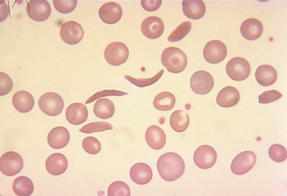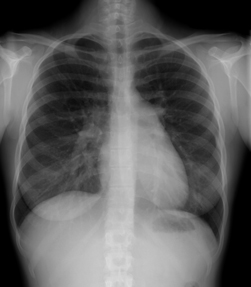‘Sic’ing primary care physicians on sickle cell disease
Sickle cell patients who survive into adulthood are falling into a gap in care as they leave a pediatric practice and don't enter an adult one. A pilot program is offering medical education to patients and to clinicians.
Children with sickle cell anemia usually get comprehensive, well-coordinated primary care.
“Pediatricians tend to do a really good job, making sure that their patients are following up with the hematologist, getting all their vaccinations and Dopplers,” said Leonard Feldman, MD, FACP, assistant professor of medicine at Johns Hopkins University School of Medicine in Baltimore.

But now that medical advances have enabled more sickle cell patients to make it to adulthood, they're falling into a gap in care.
“They are often lost as they transition from adolescent to adult care,” said Dr. Feldman. “They lost their insurance [or] they have been seeing a hematologist and think they don't need to see a primary care doctor. They find themselves receiving care by going to the emergency room or an infusion center, but not having anyone really try to keep them healthy and well.”
At Johns Hopkins and some other medical centers around the country, physicians and other clinicians are trying to correct this situation. The U.S. Department of Health and Human Services has given grants to nine facilities to develop programs to improve services for patients with sickle cell disease.
In Maryland, the result was the iHOMES (Improving Health Outcomes and Medical Education for Sickle Cell Disease) network.
“We're connecting patients with primary care providers they feel comfortable with, and cultivating a good doctor-patient relationship, but also helping to educate the primary care physicians,” said Rosalyn Stewart, MD, MBA, FACP, an associate professor of medicine at Johns Hopkins who cofounded the iHOMES network with Dr. Feldman.
A knowledge gap
A survey recently conducted by the iHOMES team found a significant need for such education. Of 129 Johns Hopkins community physicians surveyed, about 40% reported being uncomfortable with their ability to provide ambulatory care or manage comorbidities for sickle cell patients. More than half were uncomfortable managing sickle cell crises, medications and pain.
Their discomfort is understandable. “Most of the providers we deal with see between one and four sickle cell patients in their entire panel, so it's a very small fraction of the patients they see,” said Lauren Whiteman, MPH, senior research data analyst for the network. She also noted that sickle cell is “an incredibly complicated illness.”
The iHOMES network is working to remedy that shortcoming in physician training by having internal medicine residents at Johns Hopkins provide primary care to sickle cell patients. But they're also not giving up on the physicians who are already in practice.
The network offers a variety of educational programs to primary care physicians, including CME events, webinars (which are available online to physicians outside of the area) and community forums. “If they are seeing a patient and have questions for a hematologist, they can call our hotline,” added Ms. Whiteman. (Visit the iHOMES network website to access some of these free resources.)
To get to the physicians who don't reach out for help, the program does some of its own outreach. “We've done the pharmaceutical detailing technique of taking people out to dinner to fancy restaurants to teach them about sickle cell disease,” said Dr. Feldman.
Primary care needs
Some of the lessons focus on the specialized prevention and screening needs of sickle cell patients, for complications like avascular necrosis and pulmonary hypertension. “[Primary care physicians] have to be cognizant of when you start using echocardiograms to screen patients for pulmonary hypertension,” said Dr. Feldman.
Physicians may also need to be reminded about how sickle cell disease can complicate normal laboratory tests. Hemoglobin A1c tests are inaccurate in sickle cell patients, and renal markers are different, too.
“Oftentimes, a normal creatinine in a patient with sickle cell disease actually means that their kidneys aren't working quite as well,” said Dr. Feldman. Mild elevations in blood pressure are also more worrisome in sickle cell patients, Dr. Stewart noted.
Then there are the challenges of medication management. “Hydroxyurea is one of the few disease-modifying medications we have for sickle cell disease that not nearly enough of our patients are on,” said Dr. Feldman. “It's something that certainly primary care physicians can be doing.”
Appropriately treating sickle cell pain poses dilemmas for many internists. The network tries to help them with “understanding how often patients with sickle cell disease actually have pain and the origin of that pain and knowing that the patient doesn't need to come looking like they're about to die to actually be feeling pain,” Dr. Feldman said.
Uncovering the causes of pain may be one area where primary care physicians' broad perspective can particularly improve sickle cell care, according to Dr. Stewart, who described a recent interaction between one patient and his primary care physician.
“His joints were sore and he was blaming it on his sickle cell. My colleague said, ‘Yes, it could be a problem with that, but did you realize you've gained 30 pounds? Maybe we need to look at your diet.’ That's not something the hematologist had ever considered,” she said.
The iHOMES network also connects patients with dentists, as preliminary evidence has shown that good dental care can reduce the incidence of sickle cell crises.
Covering the basics
In some cases, the source of a sickle cell patient's problems may be even more basic. “It's very common for sickle cell patients to need additional support: assistance getting medications, transportation, housing,” said Ms. Whiteman.
To tackle those problems, the iHOMES network employed a community health worker, Sharon Johnson. “I try to find out what are the barriers that keep them from keeping their appointments, taking their medications,” Ms. Johnson said.
Her role provides a complement to good primary care. “The relationship between a community health worker and patient is a lot different from the relationship with doctors and nurses,” Ms. Johnson said. “We try to meet them where they're at. We're willing to go into their homes. The doctors and nurses don't have time.”
For those who have a little time to study up on sickle disease, upcoming guidelines from the National Heart, Lung and Blood Institute, scheduled to come out sometime in 2013, may be helpful.
“The guidelines aren't going to recommend anything new or dramatic,” said Kathryn Hassell, MD, a professor of hematology at the University of Colorado and one of the guideline writers. “But ... if some of the basic steps that are in these guidelines are done for everybody, the quality of care will go up tremendously. There's not a lot of evidence in sickle cell disease. It's understudied, especially in adults.”
Having recently marked the 100th anniversary of the discovery of sickle cell disease, Dr. Feldman finds the lack of research, and research funding, frustrating.
“Sickle cell is the most common genetic disease in the world,” he said. “It was the first genetic disease that was known, but by virtue of being an African-American disease, it's really been an orphan disease for a long time.”
Recent grants, like the one that supports iHOMES, represent progress, he said, “but more needs to be done.”




